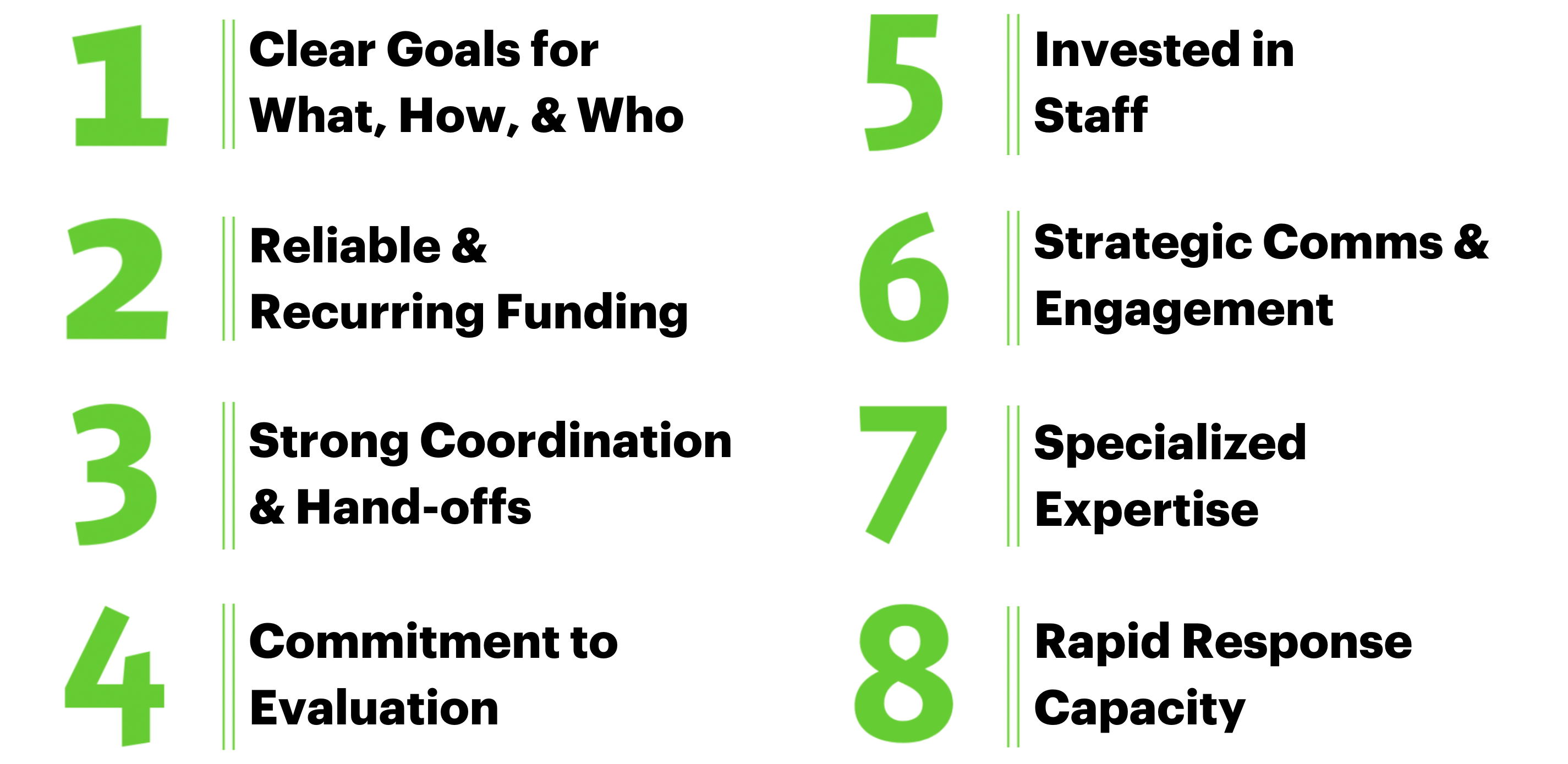
Read “Structured for Success” (PDF).
How do transportation agencies align their internal conditions to achieve their goals and objectives?
Organizational conditions—agency structure, internal processes, and transportation’s positioning within a city government—can support or hinder an agency’s ability to consistently deliver high-quality transportation projects.
This report, Structured for Success, is a starting place for transportation-minded decision-makers and advisors who want to improve project delivery in their cities. The report provides a framework to explore where transportation sits within city governments, the strengths and limitations of different configurations, and a roadmap for taking the steps necessary to make meaningful process changes.
Structured for Success synthesizes the approaches of dozens of transportation professionals who manage and shape city streets across North America. It connects research on organizational design with detailed interviews with 16 leading transportation practitioners, and survey responses from staff in 33 NACTO member cities. Structured for Success also builds upon NACTO’s previous work, including the Green Light For Great Streets initiative.
Read the full report (PDF). >
Learn more about NACTO’s Structured for Success program. >
 Today’s transportation leaders recognize the key role that transportation can play in solving, or exacerbating, today’s climate, economic, safety, equity, and health challenges. Whereas historically, transportation agencies were charged with a narrow portfolio to maintain existing street conditions, pave roads, and fill potholes, today’s transportation leaders understand that they are in the business of accessibility. They must work to reshape their city’s transportation systems to reflect values-based conversations about how people move around in cities and how different modes and needs should be prioritized.
Today’s transportation leaders recognize the key role that transportation can play in solving, or exacerbating, today’s climate, economic, safety, equity, and health challenges. Whereas historically, transportation agencies were charged with a narrow portfolio to maintain existing street conditions, pave roads, and fill potholes, today’s transportation leaders understand that they are in the business of accessibility. They must work to reshape their city’s transportation systems to reflect values-based conversations about how people move around in cities and how different modes and needs should be prioritized.
As cities’ needs have evolved, many transportation leaders report that their agency’s structure—both how the organization is set up internally, and where transportation functions are situated within their city’s overall hierarchy— hinders their ability to address critical needs. In a 2019 survey of 33 NACTO member cities conducted for Structured for Success, more than a quarter of respondents felt their organization’s structure was unhelpful for achieving their city’s desired mobility outcomes. In recent years, a number of cities have explored new structures and new ways of grouping transportation functions within their city’s hierarchy, in order to focus on transportation and deliver on essential transportation projects for the public.

When transportation functions are not well situated within city government, or when agencies are not structured to effectively deliver important projects, the repercussions are costly: key projects and priorities languish, or the projects themselves change dramatically when they move from planning to design to implementation; agencies miss important opportunities, such as when the pedestrian safety division completes a long-desired pedestrian safety project only to have the public works department tear up the street for a necessary sewer upgrade. These inefficiencies not only cost agencies time and money that they do not have to waste, but they also erode the public’s confidence in their government.
Conversely, when city agencies align internal conditions and desired outcomes, they are more likely to deliver projects on time and on budget, they can scale outputs to meet the need, and solve issues early and quickly. For example, a city that has aligned its internal conditions and desired outcomes might have a strategic paving schedule that is matched to its high-injury crash network so that dangerous corridors or streets with heavy bus use can be prioritized and redesigned quickly and efficiently.
 City practitioners routinely identify specific conditions for success; when these conditions are present, agencies tend to be able to deliver projects better and more efficiently. Often, leaders can influence or create these conditions through a combination of structure and process choices.
City practitioners routinely identify specific conditions for success; when these conditions are present, agencies tend to be able to deliver projects better and more efficiently. Often, leaders can influence or create these conditions through a combination of structure and process choices.

 For an agency to deliver on its priorities, it needs someone to champion them at the highest levels of decision-making. In fact, many believe that having a transportation “champion” is the single most important factor in whether cities can successfully build transportation projects. City agencies exist in a complex political environment with many competing priorities; having a transportation champion with a direct line to the mayor is a valuable asset for advancing priorities. Without a champion for transportation projects who can advocate upwards while mediating transportation-related disputes across agencies or divisions, projects can get stuck, be tabled, or never get prioritized to start with.
For an agency to deliver on its priorities, it needs someone to champion them at the highest levels of decision-making. In fact, many believe that having a transportation “champion” is the single most important factor in whether cities can successfully build transportation projects. City agencies exist in a complex political environment with many competing priorities; having a transportation champion with a direct line to the mayor is a valuable asset for advancing priorities. Without a champion for transportation projects who can advocate upwards while mediating transportation-related disputes across agencies or divisions, projects can get stuck, be tabled, or never get prioritized to start with.
 When all or nearly all transportation functions are organized into a single Transportation-Focused agency, the director or commissioner is often well placed to be the champion. This is the case in Denver or Toronto. In a city like Detroit, however, where transportation functions are housed with- in multiple departments, the city’s Chief Operating Officer, who sits above the transportation agency in the city’s hierarchy, serves as the transportation champion, overseeing a large group of agencies and coordinating regular meetings between agency heads. Similarly, in Boston, the Chief of Streets in the mayor’s cabinet fills the champion role and oversees a narrow set of streets-focused agencies. In Austin, where the mayor sits as the head of the City Council, the mayor also serves as transportation champion, elevating transportation issues to their legislative colleagues.
When all or nearly all transportation functions are organized into a single Transportation-Focused agency, the director or commissioner is often well placed to be the champion. This is the case in Denver or Toronto. In a city like Detroit, however, where transportation functions are housed with- in multiple departments, the city’s Chief Operating Officer, who sits above the transportation agency in the city’s hierarchy, serves as the transportation champion, overseeing a large group of agencies and coordinating regular meetings between agency heads. Similarly, in Boston, the Chief of Streets in the mayor’s cabinet fills the champion role and oversees a narrow set of streets-focused agencies. In Austin, where the mayor sits as the head of the City Council, the mayor also serves as transportation champion, elevating transportation issues to their legislative colleagues.
Regardless of exactly where they sit, these transportation champions must be well positioned to connect projects to citywide policies, compete for and prioritize transportation funding, and ensure that efforts taken on by one agency do not undermine transportation efforts in another. By that same token, these champions need political support and backing from above. They must be able to stick to plans that might be controversial without fear of being fired or undermined. Lack of political support can take out even the strongest leader, rendering transportation strategy rudderless and unable to articulate or execute a vision of any kind.

 When effective agency structure is supported by a strong champion and is bolstered by effective processes, cities can take advantage of, or even create, conditions for success and deliver on their transportation projects and goals. Examples from across North America indicate that agencies are most capable of effectively delivering transportation projects and policies when:
When effective agency structure is supported by a strong champion and is bolstered by effective processes, cities can take advantage of, or even create, conditions for success and deliver on their transportation projects and goals. Examples from across North America indicate that agencies are most capable of effectively delivering transportation projects and policies when:
- Transportation is housed in a “Transportation-focused” agency that is responsible for most or all transportation functions in a city;
- There is a transportation-focused leader—a “champion”—with a direct line to the mayor or decision-making authority; and
- The transportation agency has proactively established transparent internal processes for project delivery and can coordinate and communicate effectively, both internally and with the public.
This trifecta of structure, people, and process sets cities up to be successful in delivering on transportation projects and goals. There are, of course, cities without a transportation-focused agency who successfully deliver high quality transportation projects in line with their goals thanks to strong transportation championship, robust project hand-off processes, and a commitment to re-evaluating internal structures that are not serving their purpose.
Well-established processes and agreements for project hand-offs between agencies can mitigate the impact of a more diffuse transportation structure. Similarly, a strong transportation “champion” may be able to resolve disputes between agencies when processes are lacking. As cities look to improve how they provide transportation services and options to the public and meet their goals, strengthening all three factors—structure, process, and championship—is essential.
For more, read the full report (PDF). >